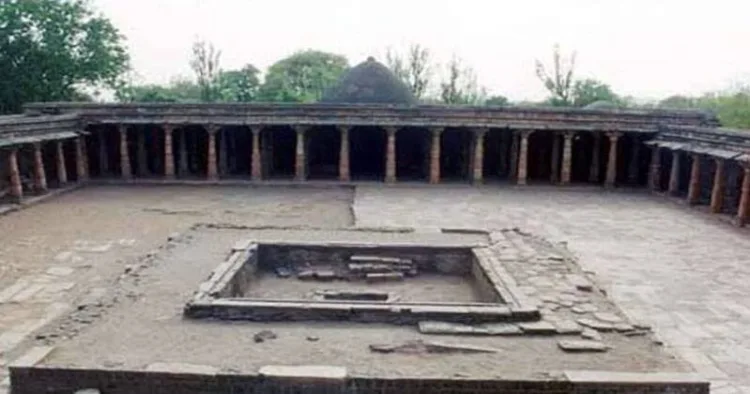The ASI (Archaeological Survey of India) is conducting a survey of the historic Bhojshala complex in Dhar, Madhya Pradesh. On the 86th day of the survey, the Saraswati Koop located in the complex was photographed and measured.
ASI has to submit the report in the first week of July. In such a situation, the ASI team will present the evidence that has come to light regarding Bhojshala during the survey before the court.
Bhojshala Mukti Yagna coordinator Gopal Sharma said that the work of filling soil in the North-Eastern part continued on June 16. Two symbols were found in the soil, and the survey team has preserved them.
At the same time, another team visited Saraswati Koop in Kamal Maulana’s premises, taking photographs and measurements. Petitioner Abdul Samad mentioned that the remaining levelling work in the northern part proceeded. Videography and photography of the pillars were conducted, and excavation was carried out, with trenches on the premises being closed. Measurement work at Akal Kuiya was also completed.
Previously, on the 85th day of the ASI survey at Bhojshala, a team of 16 ASI members and 36 labourers arrived at 6:00 am to commence their survey work. As it was a Friday, the survey concluded at 12:00 pm. Subsequently, from 1:00 pm to 3:00 pm, members of the Muslim community gathered at the Bhojshala premises to observe their Friday prayers (namaz).
Also, on the 84th day of the survey at Bhojshala, eight officials and 27 labourers assembled promptly at 7:00 am to conduct the work methodically. Half of the officials dedicated their efforts within the premises until 5:00 pm. Significant excavation occurred at the corner of the north-eastern part of Garbha Griha, involving the removal of soil and collection of ancient remains. The team meticulously levelled the pits as part of their scientific survey.
The Bhojshala complex serves as a temple on Tuesdays and a mosque on Fridays and becomes a common monument on weekdays, allowing visits with a ticket of Rs 1 per person. The structure is being taken care of by the security personnel deployed by the ASI.
The Hindu side claims the structure to be Maa Vaghdevi temple dating back to 1000 to 1055 AD when it was built by the king Bhoj of the Parmar dynasty who had an unwavering dedication to enlightenment and scholarship manifested in the establishment of a prestigious college in Dhar, which later evolved into the renowned Bhojshala. Drawing scholars from far and wide, this bastion of learning nurtured disciplines ranging from music and Sanskrit to astronomy and philosophy, earning its reputation as the world’s foremost Sanskrit academy.
However, amidst the pursuit of knowledge, the sanctuary of Bhojshala endured turbulent times. Throughout the annals of history, waves of turmoil swept over the hallowed grounds, orchestrated by successive Muslim monarchs between 1305 and 1514 AD. The destructive fervour culminated in the ruthless onslaught of Alauddin Khilji in 1305 AD, marking the first of many assaults on the majestic temple.
In the early 2000s, the sanctuary became embroiled in a political maelstrom, as administrative decisions threatened its sanctity. With the backing of the Congress government, the Muslim community was granted permission to offer prayers within the premises, while Hindu devotees faced prohibitions and police cases. The ensuing conflict bore witness to acts of violence and resistance, culminating in a legal battle that saw the faithful reclaim of their right to worship.



















Comments